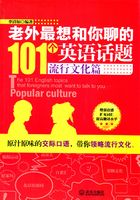
第24章 Foreign Cultures 谈论外国文化(9)
At the time of War in 1812, Uncle Sam Wilson obtained a contract to supply beef to the Army, which he shipped in barrels。 Those barrels, being government property, were branded with the initials “U。S”, people would joke that the initials referred to “Uncle Sam”。
1812年第二次美英战争,山姆?威尔逊大叔获得为美军供给牛肉的合同。这些桶装的牛肉,作为政府财产烙有“美国”的英文首字母。人们开玩笑称烙着的首字母表示“山姆大叔”。
Uncle Sam was a man of great fairness, reliability, honesty, and he was willing to contribute for the country。
山姆大叔是一个公平、可靠、诚实,乐于为国做贡献的人。
Uncle Sam is depicted as an elderly man with white hair and a goatee beard。
山姆大叔被描绘成一个有着白发和山羊胡子的老人。
The name of “Uncle Sam” and his vivid images can be often seen in newspapers, magazines, literatures and comic books in America。
在美国的报纸杂志、文学作品和漫画中,经常可以看到“山姆大叔”的名字及其生动的形象。
Uncle Sam was used on behalf of “American” or “U。S。 Government”, mainly in the United States, Britain, especially in the media。
山姆大叔被用来代指“美国”或“美国政府”,主要在美国、英国,尤其是在新闻界中使用较多。
The image of “Uncle Sam” was based on an early cartoon character “Brother Jonathan”, who was very famous during the American War of Independence。
山姆大叔的原型是一个早期漫画人物,名叫“乔纳森大哥”,此人在美国独立战争时期非常出名。
Uncle Sam became a useful icon in cartoons, much like the John Bull character who represented the United Kingdom。 John Bull and Uncle Sam have squared off in hundreds of political cartoons throughout the years。
山姆大叔成了漫画有用的图标,很像约翰牛的形象代表英国。约翰牛和山姆大叔已经在数以百计的政治漫画中出现了许多年。
The most famous image of the Uncle Sam persona was a World War I recruiting image that depicted a stern Sam pointing his finger at the viewer and declaring, “I want you”。 It was painted by artist James Montgomery Flagg in 1916, just prior to US involvement in World War I, by or even based on the character Sam Slick, created by Canadian。
山姆大叔最有名的人物形象是第一次世界大战的招兵形象,描绘了一个严峻的山姆指着观众宣布:“我要你。”这是画家弗拉格?詹姆斯?蒙哥马利在1916年之前创作的,恰巧早于美国卷入第一次世界大战,是根据加拿大创作的山姆?史利克的形象创作的。
Let’s Talk!
开始交流吧!
Son: Dad, can I ask you a question?
儿子:爸爸,我能问你一个问题吗?
Dad: Yes, dear son。
爸爸:说吧,宝贝儿子。
Son: Do you know Uncle Sam’s story?
儿子:你知道山姆大叔的故事吗?
Dad: Certainly, all Americans know it。
爸爸:当然知道啦,全美国没有谁不知道啊。
Son: But I do not know。
儿子:我就不知道。
Dad: You are young。 When you grow up, you will know。
爸爸:你还小,等你长大了,你就知道了。
Son: Can you tell me his story?
儿子:那你能告诉我他的故事吗?
Dad: Yeah, once there was a meat packer in New York, honest and capable, the locals called him “Uncle Sam”。 During the war, he was responsible for stamping on the barrels of beef and wine for the military。 One day, the New York governor went to inspect and found the “US” on the barrels, both the abbreviation for the United States and Uncle Sam, so that Uncle Sam became famous。
爸爸:可以啊,纽约州有一位肉类包装商,诚实能干,当地人都叫他“山姆大叔”。战争期间,他负责在供应军队的牛肉桶和酒桶上打戳。有一天,纽约州长去视察,就发现桶上有US的字样,既是美国的缩写,又是山姆大叔的缩写,这样山姆大叔就出名啦。
Son: But why Uncle Sam is now a synonym for the United States?
儿子:可为什么现在山姆大叔是美国的代名词呢?
Dad: Because Uncle Sam is honest, hard-working and he has a spirit of patriotism, which is suitable to describe our country。
爸爸:因为山姆大叔诚实可靠、吃苦耐劳以及具有爱国主义的精神,很适合形容我们的国家啊。
Son: Oh, thank you Dad, I know, I want to become someone like Uncle Sam。
儿子:哦,谢谢爸爸,我明白了,我也要变成山姆大叔那样的人。
Japanese Kimono and Wine
日本的和服和清酒
说起日本文化,有人可能会想到生鱼片、寿司、木屐,但日本文化最精粹的当属日本的和服以及清酒,下面让我们去认识一下吧。
和服,江户时代以前通常指吴服,是日本的一种民族服饰。语出《古事记》、《日本书纪》、《松窗梦语》。明治时代前,和服泛指所有服装,而与这个词相对的是洋服,指来自西洋的衣饰。后来此词的词意逐渐单一化,通常单指具有日本特色的民族服装。
清酒,日本称为日本酒,英语称为Sake,是用大米酿制的一种粮食酒,制作方法和中国的糯米酒相似,先用熟米饭制曲,再加米饭和水发酵,不过日本清酒比中国的糯米酒度数高,但比不上蒸馏酒,最高浓度可达到20%。
Realize Kimono and Wine
认识和服和清酒
1和服的历史
The kimono is a Japanese traditional garment worn by women, men and children。 The word “kimono”, which literally means a “thing to wear”, has come to denote these full-length robes。 The standard plural of the word kimono in English is kimonos, but the unmarked Japanese plural kimono is also sometimes used。 Kimonos are T-shaped, straight-lined robes worn so that the hem falls to the ankle, with attached collars and long, wide sleeves。 Kimonos are wrapped around the body, always with the left side over the right (except when dressing the dead for burial), and secured by a sash called an obi, which is tied at the back。 Kimonos are generally worn with traditional footwear and split-toe socks。
Today, kimonos are most often worn by women, and on special occasions。 Traditionally, unmarried women wore a style of kimono called furisode, with almost floor-length sleeves, on special occasions。 A few older women and even fewer men still wear the kimono on a daily basis。 Men wear the kimono most often at weddings, tea ceremonies, and other very special or very formal occasions。 Professional sumo wrestlers are often seen in the kimono because they are required to wear traditional Japanese dress whenever appearing in public。
As the kimono has another name gofuku, the earliest kimonos were heavily influenced by traditional Han Chinese clothing, known today as hanfu, through Japanese embassies to China which resulted in extensive Chinese culture adoptions by Japan, as early as the fifth century。
It was during the 8th century, however, when Chinese fashions came into style among the Japanese, and the overlapping collar became particularly a women’s fashion。 During Japan’s Heian period (794–1192AD), the kimono became increasingly stylized, though one still wore a half-apron。 During the Muromachi age (1392–1573 AD), the Kosode, a single kimono formerly considered as underwear, began to be worn without the hakama over it, and thus began to be held closed by an obi “belt”。 During the Edo period (1603–1867 AD), the sleeves began to grow in length, especially among unmarried women, and the Obi became wider, with various styles of tying coming into fashion。
2清酒的历史